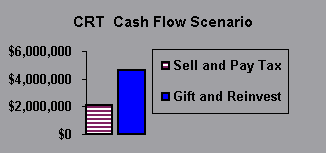Incentive Stock Options and the CRT
Incentive Stock Options and the CRT

George Rivera (47) is an industrial engineer with a midwest manufacturing company; his wife, Nancy Rivera (45), is a nurse with a local physicians’ group. George is well compensated and has been provided with incentive stock options as an executive benefit, and he has been exercising them annually with money from his year-end bonus. The qualified options allow George to purchase his employer’s stock at far below market price and his net worth has steadily appreciated over the last few years with continued company growth. Although any stock acquired through an option and held for at least one year qualifies for capital gains treatment, which is usually more advantageous than paying tax at his marginal rate, it still means he turns 30% of his retirement dollars into tax dollars in a normal sale. This is wasteful and unnecessary, see why below.
George’s employer provides access to financial planning services as a company perk. Counseling increased diversification to reduce his exposure to any downturns in the market, his planner is concerned how a decline would affect George’s one stock portfolio. His advisors suggested the use of an IRC §664 Charitable Remainder Trust to bypass the income tax liabilities when he repositions his growth portfolio into one more suitable for wealth preservation and prudent retirement planning. Besides the financial advantages of a CRT, there were also the issues of what money and wealth meant to his family. As a part of the Rivera’s financial plan, George and Nancy completed a profile that detailed their family financial philosophy. While tax avoidance was important, it wasn’t their only motivating influence. Although, the Riveras have no children, they have been active in local community affairs and feel that they have a vested interest in the town where both of their families have been living for many years. With no particular desire to leave distant family with a large inheritance, the Riveras chose retirement security, inflation protection, asset preservation and community projects as more important features of their plan, and the CRT meets those goals very effectively. Even if tax avoidance is the only priority, this performs exceptionally well; but when factoring in the “social capital” issues, the CRT formed the core strategy of their estate and financial plan. As trustees of their own CRT, the Riveras control the assets and investment management decisions and still retain the right to modify the charitable institutions scheduled to receive assets when the trust terminates. As there will be an estimated $8.9 million in social capital inside their charitable trust, it has great potential to impact the local community.
Henry & Associates designed the Rivera scenario* and compared the two options of (a) selling stock and paying the income tax, reinvesting the balance at 10% or (b) gifting the stock to an IRC §664 Trust and reinvesting all of the sale proceeds in a similar 10% equity based portfolio. At the maturation of the CRT, when the surviving spouse (most likely Nancy) passes away, the assets inside the trust will pass to a community hospital and nonprofit nursing home. These organizations provided the Rivera family with health care over the years and deserve their support, although if the Riveras decide to expand the list of charitable remainder recipients, that’s an option.
| Incentive Stock Options and a CRT Strategy (seehttp://members.aol.com/CRTrust/CRT.htmlfor other tools) | Sell Taxable ISO Stock Reinvest the Balance (A) | Gift Asset to §664 CRT and Reinvest (B) |
| Fair Market Value of Stock |
$1,000,000 |
$1,000,000 |
| Less: Tax Basis |
$300,000 | |
| Equals: Gain on Sale |
$700,000 | |
| Less: Capital Gains Tax (federal and state combined) |
$210,000 | |
| Net Amount at Work |
$790,000 |
$1,000,000 |
| Annual Return From Asset Reinvested in Balanced Acct @ 10% |
$79,000 | |
| Avg. Annual Return From Asset in 5% CRUT Reinvested @ 10% |
$171,753 | |
| After-Tax (40%) Avg. Spendable Income |
$47,400 |
$103,052 |
| Statistical Number of Years of Cash Flow for Income Beneficiaries |
44 |
44 |
| Taxes Saved from $179,900 Deduction at 40% Marginal Rate |
$71,960 | |
| Tax Savings and Cash Flow over Joint Life Expectancies |
$2,085,600 |
$4,606,250 |
Hypothetical evaluations are provided as a professional courtesy to members of the estate planning community. Call for suggestions.
©Vaughn W. Henry, 1997